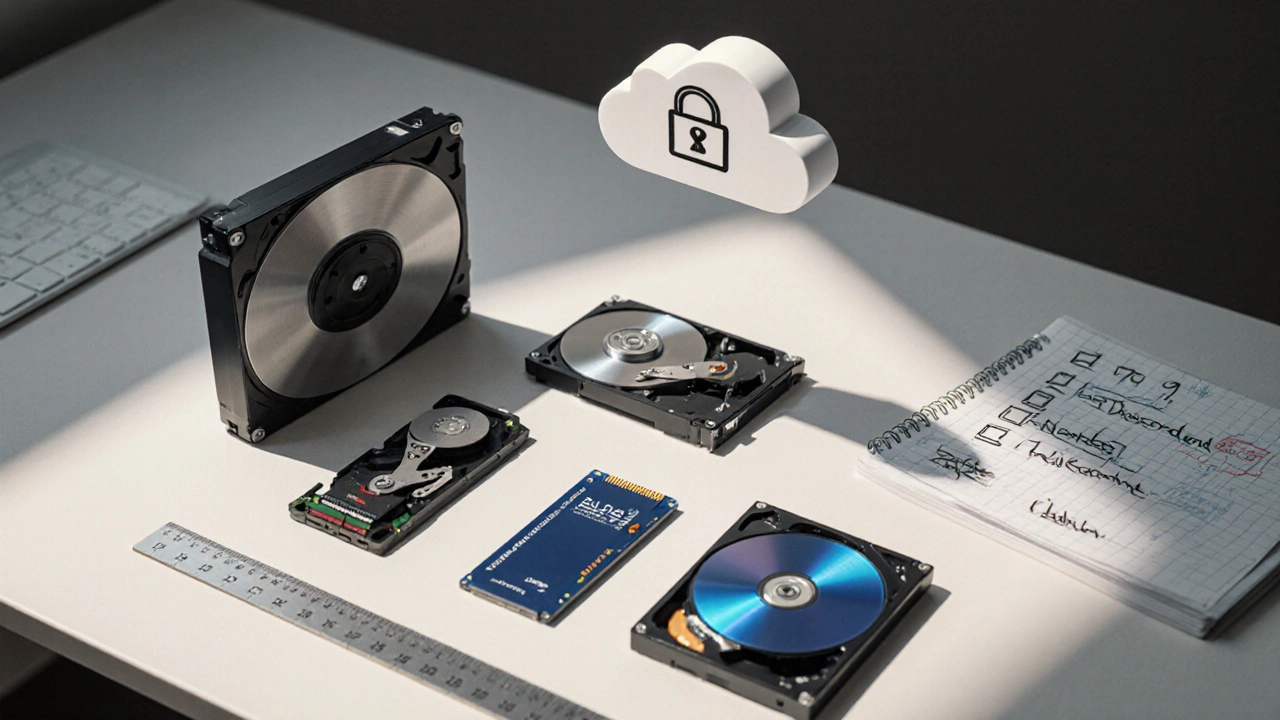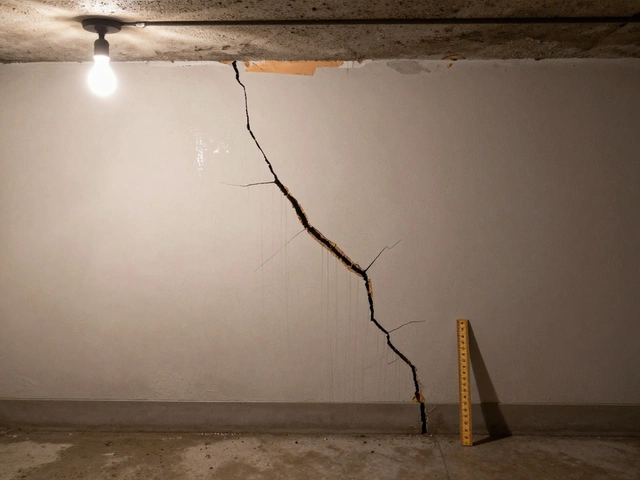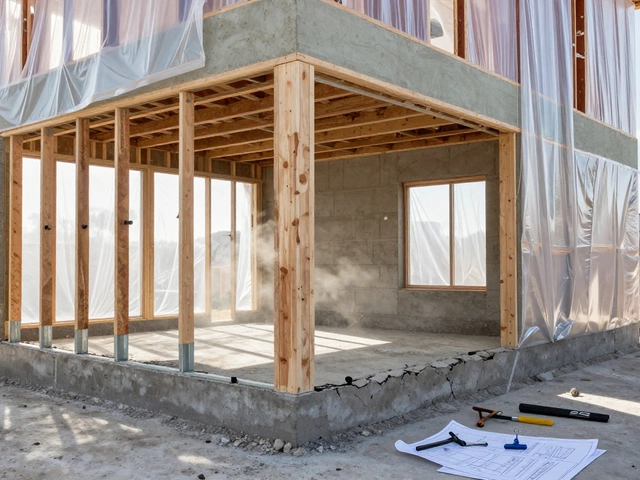Long-Term Data Storage Selector
Recommended Storage Medium
When you need to keep files safe for years-or even decades-the choice of storage matters more than you might think. You want something that won’t corrupt, won’t cost an arm and a leg, and will stay readable as technology moves on. Below you’ll find a plain‑spoken guide that walks you through the main options, the real‑world trade‑offs, and a quick way to decide what fits your needs.
Key Takeaways
- Magnetic tape still offers the best cost‑per‑gigabyte for massive archives.
- Solid‑state drives give fast access but cost more and have limited lifespan for cold storage.
- Cloud archival services such as AWS Glacier provide convenience and geographic redundancy, but ongoing fees add up over time.
- Optical discs (BD‑XL) are cheap and immune to magnetic fields, yet they cap out at ~128GB per disc.
- Match media to three criteria - durability, access frequency, and budget - to avoid over‑paying.
Understanding Longevity Requirements
First, ask yourself how often you’ll need the data. If you’re storing tax records that you’ll pull once a year, you’re in the "cold" category. If you need to access video logs daily, you’re in the "hot" category. Cold data can sit untouched for 10‑30years without a problem, while hot data needs fast retrieval speeds.
Second, think about the environment. Temperature swings, humidity, and magnetic fields can all degrade storage media. A climate‑controlled closet or a data‑center rack will protect most devices, but nothing beats a medium that’s inherently resistant to those factors.
Third, calculate the total cost of ownership (TCO). It’s not just the price tag you pay today; it’s the power you consume, the maintenance you perform, and the fees you’ll pay year after year. A cheap drive that burns 10W constantly can out‑spend a $100 tape library over five years.
Evaluating Storage Media
Below is a quick rundown of the most common media you’ll encounter. Each paragraph introduces the media as a Long‑term data storage medium designed to preserve information for extended periods option.
Hard Disk Drives (HDD)
Hard Disk Drive a magnetic platter‑based storage device common in personal computers offers a familiar balance of cost and capacity. Modern 4‑TB enterprise HDDs sit around $100, giving you about $0.025/GB upfront.
- Durability: Typically rated for 3‑5years of active use; idle storage can last longer, but the mechanical parts are vulnerable to shock and wear.
- Access speed: 150‑200MB/s for sequential reads - fast enough for weekly backups.
- Power: 6‑9W while spinning, adding up if you keep dozens running.

Solid State Drives (SSD)
Solid State Drive a flash‑based storage device with no moving parts shines when you need instant access. Prices have dropped to $0.08/GB for consumer‑grade SATA SSDs, but enterprise NVMe models still hover around $0.15/GB.
- Durability: Data retention without power is about 5‑10years for high‑quality MLC/NAND; cheaper TLC can lose bits sooner.
- Access speed: 500‑3,500MB/s, perfect for daily restores.
- Power: Under 3W idle, making them greener than HDDs when left on.
Magnetic Tape
Magnetic Tape a linear strip of magnetic coating used in reel‑to‑reel or cartridge form may feel old‑school, but it dominates the archival market. LTO‑9 tapes store 18TB (uncompressed) at roughly $100 per cartridge.
- Durability: 30‑50years when stored at 15‑25°C and < 40% humidity - the longest of any consumer‑grade medium.
- Access speed: 400‑500MB/s streaming, but you must load the tape first, so random reads are slower.
- Cost: $0.005/GB for media alone, making it the cheapest for petabyte‑scale archives.
Optical Disc (BD‑XL)
Optical Disc a laser‑readable medium such as Blu‑ray Disc (BD‑XL) that stores up to 128GB per disc excels in environments where magnetic fields are a concern. A pack of 25BD‑XL discs costs about $60.
- Durability: Up to 20years if kept in a cool, dry box; scratches can render a disc unreadable.
- Access speed: 30‑50MB/s - fine for occasional restores but not for bulk transfers.
- Portability: Small and lightweight, ideal for off‑site copies.
Cloud Archival Services
Cloud Archival Service a managed, low‑cost storage tier from providers like AWS Glacier, Google Coldline, or Azure Archive removes the hardware headache. You upload data once, and the provider replicates it across multiple data centers.
- Durability: 99.999999999% (eleven 9’s) durability - effectively “infinite” as long as the provider stays alive.
- Access speed: Retrieval can take minutes to hours, depending on the “expedited” or “standard” option.
- Cost: $0.004/GB per month for storage + $0.01/GB for data retrieval - cheap for small amounts, but costs climb with frequent restores.
Decision Checklist & Comparison Table
Use the checklist below to match your project to the right medium:
- Is the data “cold” (access < once a year)? → Tape or Cloud Archive.
- Do you need instant access? → SSD or HDD.
- Is budget the primary constraint? → Tape (media only) or Optical Disc.
- Do you want off‑site redundancy without managing hardware? → Cloud Archive.
| Media | Cost/GB (upfront) | Retention (years) | Access Speed | Power Use | Typical Use‑Case |
|---|---|---|---|---|---|
| Hard Disk Drive | $0.025 | 5‑10 | 150‑200MB/s | 6‑9W | Weekly backups, on‑prem archives |
| Solid State Drive | $0.080 | 5‑10 (high‑grade) | 500‑3,500MB/s | <2W | Daily restores, high‑performance cache |
| Magnetic Tape (LTO‑9) | $0.005 | 30‑50 | 400‑500MB/s (sequential) | 0W (offline) | Petabyte‑scale cold archives |
| Optical Disc (BD‑XL) | $0.020 | 10‑20 | 30‑50MB/s | 0W (offline) | Off‑site copies, legal records |
| Cloud Archival Service | $0.004/GB/month | Indefinite (provider guarantee) | Minutes‑hours (retrieval) | N/A (no hardware) | Distributed backups, multi‑region compliance |
Practical Tips for Maximizing Longevity
- Refresh every 5‑7years. Even the best media can develop bit‑rot. Plan a migration window and verify checksums.
- Use error‑correcting codes. Formats like LTO include built‑in ECC; for HDD/SSD you can add tools such as ZFS or SnapRAID.
- Store in a stable environment. Aim for 18‑22°C and 40‑45% relative humidity. Avoid basements that flood or attics that overheat.
- Keep multiple copies. The 3‑2‑1 rule still applies: three total copies, on two different media, with one off‑site.
- Document the media. Write down cartridge serial numbers, tape generation, and the encryption key used. Future you will thank you.
Frequently Asked Questions
How long can a hard drive actually keep data without power?
A well‑sealed HDD can retain data for about 5‑10years if stored in a cool, dry place. Magnetic grains slowly lose alignment over time, so periodic checks are advised.
Is magnetic tape still viable for a small business?
Absolutely. A single LTO‑9 cartridge can hold 18TB of data for under $100. For a small business that needs to archive invoices, logs, or video surveillance, tape gives the best price per gigabyte and the longest shelf life.
What’s the biggest downside of cloud archival services?
Retrieval fees can surprise you if you pull data often. Also, you’re trusting a third‑party’s financial health and compliance policies, so budgeting for potential price changes is wise.
Can I rely on optical discs for 30‑year storage?
Most consumer‑grade Blu‑ray discs are rated for about 20years. For a true 30‑year plan, you’d need archival‑grade discs (e.g., M‑Disc) which claim 100‑year durability, but they’re pricier and less widely available.
Do SSDs degrade even when not in use?
Flash cells lose charge over time, a process called data retention loss. High‑end enterprise SSDs can hold data for up to 10years without power, but cheaper consumer ones may start losing bits after 3‑5 years.
Next Steps
1. List every data set you need to protect and label it “hot”, “warm”, or “cold”.
2. Run a cost calculator: multiply storage size by the per‑GB cost from the table, then add power or subscription fees over a 5‑year horizon.
3. Choose a primary medium (e.g., tape for bulk archives) and a secondary copy (e.g., cloud archive) to satisfy the 3‑2‑1 rule.
4. Schedule a migration audit in three years to verify checksum integrity and refresh any media that’s nearing its spec limit.
With the right mix, you’ll avoid the nightmare of lost files and keep your digital vault secure for the decades ahead.








